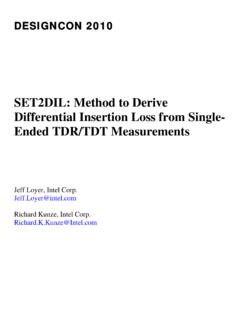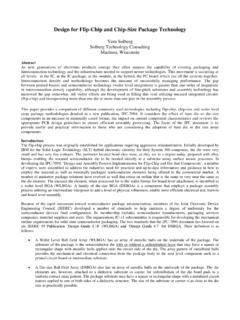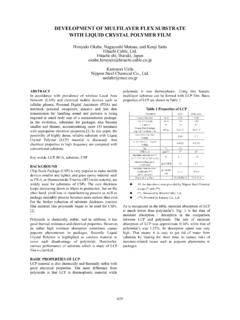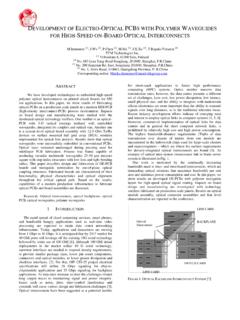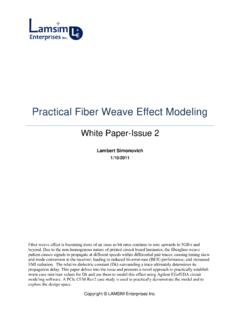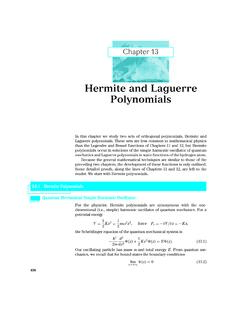Transcription of Time and Frequency Domains - Magazines
1 43 CHAPTER2 Time and Frequency DomainsIn this chapter, we explore the basic properties of signals in preparation for look-ing at how they interact with interconnects. We will find that there are multipleways of looking at a signal, each providing a different perspective. The quickestpath to the answer may not be the most obvious path. The different perspectiveswe will use to look at signals are called Domains . In particular we ll use the timedomain and the Frequency will find that while we may generally be more familiar with the timedomain, the Frequency domain can provide valuable insight to understand andmaster many signal-integrity effects such as impedance, lossy lines, the power-distribution network, measurements, and introducing the two Domains , we will look at how to translate betweenthe two for some special cases.
2 We will apply what we learn to relate two impor-tant quantities: rise time and bandwidth. The first is a time-domain term and thesecond a Frequency -domain term. However, as we will see, they are , we ll apply this concept of bandwidth to interconnects, models, Page 43 Tuesday, June 9, 2009 11:24 AM44 Chapter 2 Time and Frequency The Time DomainWe use the term a lot the time domain. But what do we really mean? What is thetime domain? What are the features that are special about the time domain thatmake it useful? These are surprisingly difficult questions to answer because theyseem so obvious and we rarely think about what we really mean by the take it for granted because from the moment we are born, our experi-ences are developed and calibrated in the time domain.
3 We are used to seeingevents happen with a time stamp and ordered time domain is the world of our experiences and is the domain in whichhigh-speed digital products perform. When evaluating the behavior of a digitalproduct, we typically do the analysis in the time domain because that s where per-formance is ultimately measured. For example, two important properties of a clock waveform are clock periodand rise time. Figure 2-1 illustrates these features. The clock period is the time interval to repeat one clock cycle, usually mea-sured in nanoseconds (nsec). The clock Frequency , Fclock, or how many cycles persecond the clock goes through, is the inverse of the clock period, Tclock.(2-1)where:Fclock = the clock Frequency , in GHzTclock = the clock period, in nsecFor example, a clock with a period of 10 nsec will have a clock Frequency of1/10 nsec = GHz or 100 rise time is related to how long it takes for the signal to transition from alow value to a high value.
4 There are two popular definitions of rise time. The 10 90 rise time is how long it takes for the signal to transition from 10% of its finalvalue to 90% of its final value. This is usually the default meaning of rise time. Itcan be read directly off the time domain plot of a I P The time domain is the real world. It is the only domainthat actually exists. Fclock1 Tclock--------------= Page 44 Tuesday, June 9, 2009 11:24 AMThe Time Domain45 The second definition is the 20 80 rise time. This is the time it takes for thesignal to transition from 20% of its final value to 80% of its final value. Of course,for the same waveform the 20 80 rise time is shorter than the 10 90 rise IBIS models of real devices use the 20 80 definition of rise time.
5 Thismakes it confusing. To remove ambiguity, it s often good practice referring explic-itly to the 10 90 rise time or the 20 80 rise time. There is a corresponding value for the fall time of a time-domain on the logic family, the fall time is usually slightly shorter than the risetime. This is due to the design of typical CMOS output drivers. In a typical outputdriver, a p and an n transistor are in series between the VCC (+) and the VSS ( )power rails. The output is connected to the center, between them. Only one tran-sistor is on at any one time, depending on whether the output is a low or a high. When the driver switches from a low to a high ( , rising edge), the n tran-sistor turns off and the p transistor turns on. The rise time is related to how fast thep transistor can turn on.
6 When switching from the high to the low state ( , a fall-ing edge), the p transistor turns off and the n transistor turns on. In general, for thesame feature-size transistor, an n transistor can turn on faster than a p means switching from high to low, the falling edge will be shorter than therising edge. In general, signal-integrity problems are more likely to occur whenswitching from a high to low transition than from a low to high transition. ByFigure 2-1 Typical clock waveform showing the clock period and the10 90 rise time for a 1-GHz clock. The fall time is typically slightly shorterthan the rise time and sometimes creates more , nsecrise Page 45 Tuesday, June 9, 2009 11:24 AM46 Chapter 2 Time and Frequency Domainsmaking the n channel transistor larger than the p channel, the rising and fallingedges can be closely matched.
7 Having established an awareness of the time domain as a distinct way oflooking at events, we can turn our attention to one of a number of alternative waysof analyzing the world the Frequency Sine Waves in the Frequency DomainWe hear the term Frequency domain quite a bit, especially when it involves radiofrequency (rf) or communications systems. We will also encounter the frequencydomain in high-speed digital applications. There are few engineers who have notheard of and used the term multiple times. Yet, what do we really mean by thefrequency domain? What is the Frequency domain and what makes it special anduseful?The most important rule in the Frequency domain is that the only kind ofwaveforms that exist are sine waves.
8 Sine waves are the language of the frequencydomain. There are other Domains that use other special functions. For example,the JPEG picture-compression algorithm takes advantage of special waveformsthat are called wavelets. The wavelet transform takes the space domain, with a lotof x-y amplitude information content, and translates it into a different mathemati-cal description that is able to use less than 10% of the memory to describe thesame information. It is an approximation, but a very good one. It s common for engineers to think that we use sine waves in the frequencydomain because we can build any time-domain waveform from combinations of sinewaves. This is a very important property of sine waves.
9 However, there are manyother waveforms with this property. It is not a property that is unique to sine fact, there are four properties that make sine waves very useful fordescribing any other waveform. These properties are as follows:T I P The most important quality of the Frequency domain isthat it is not real. It is a mathematical construct. The only reality isthe time domain. The Frequency domain is a mathematical worldwhere very specific rules are Page 46 Tuesday, June 9, 2009 11:24 AMSine Waves in the Frequency waveform in the time domain can be completely and uniquely described by combinations of sine two sine waves with different frequencies are orthogonal to each other. If you multiply them together and integrate over all time, they integrate to zero.
10 This means you can separate each component from every are well defined mathematically. have a value everywhere with no infinities and they have derivatives that have no infinities anywhere. This means they can be used to describe real world waveforms, since there are no infinities in the real of these properties are vitally important, but are not unique to sine is a whole class of functions called orthonormal functions, or sometimescalled eigenfunctions or basis functions, which could be used to describe anytime-domain waveform. Other orthonormal functions are hermite Polynomials,Legendre Polynomials, Laguerre Polynomials, and Bessel did we choose sine waves as our functions in the Frequency domain?
